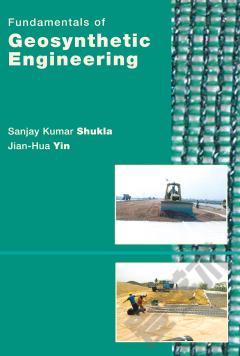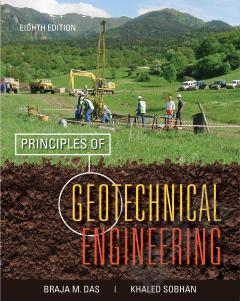Fundamentals of Geosynthetic Engineering
Preface Acknowledgements Chapter 1 General Description Introduction 1.1 Geosynthetics,1.2 Basic Characteristics,1.3 Raw Materials,1.4 Manufacturing Processes,1.5 Geosynthetic Engineering, Self Evaluation Questions Chapter 2 Functions and Selection 2.1 Introduction, 2.2 Functions, 2.3 Selection, Self Evaluation Questions Chapter 3 Properties and Their Evaluation 3.1 Introduction, 3.2 Physical Properties, 3.3 Mechanical Properties, 3.4 Hydraulic Properties, 3.5 Endurance and Degradation Properties, 3.6 Test and Allowable Properties, 3.7 Description of Geosynthetics, Self Evaluation Questions Chapter 4 Application Areas 4.1 Introduction 4.2 Retaining Walls, 4.3 Embankments, 4.4 Shallow Foundations, 4.5 Roads, 4.5.1 Unpaved roads, 4.5.2 Paved roads, 4.6 Railway Tracks, 4.7 Filters and Drains, 4.8 Slopes,,4.8.1 Erosion control, 4.8.2 Stabilization, 4.9 Containment Facilities, 4.9.1 Landfills, 4.9.2 Ponds, reservoirs, and canals, 4.9.3 Earth dams,4.10 Tunnels,4.11 Installation Survivability Requirements,Self Evaluation Questions Chapter 5 Analysis and Design Concepts 5.1 Introduction, 5.2 Design Methodologies, 5.3 Retaining Walls, 5.4 Embankments, 5.5 Shallow Foundations, 5.6 Roads: 5.6.1 Unpaved roads, 5.6.2 Paved roads, 5.7 Railway Tracks, 5.8 Filters and Drains, 5.9 Slopes: 5.9.1 Erosion control, 5.9.2 Stabilization, 5.10 Containment Facilities:5.10.1 Landfills, 5.10.2 Ponds, Reservoirs, and Canals, 5.10.3 Earth Dams, 5.11 Tunnels, Self Evaluation Questions Chapter 6 Application Guidelines 6.1 Introduction, 6.2 General Guidelines, 6.2.1 Care and consideration, 6.2.2 Geosynthetic selection, 6.2.3 Identification and inspection, 6.2.4 Sampling and test methods, 6.2.5 Protection before installation, 6.2.6 Site preparation, 6.2.7 Geosynthetic installation, 6.2.8 Joints/seams, 6.2.9 Cutting of geosynthetics, 6.2.10 Protection during construction and service life, 6.2.11 Damage assessment and correction, 6.2.12 Anchorage, 6.2.13 Prestressing, 6.2.14 Maintenance, 6.2.15 Certification,6.2.16 Handling the refuse of geosynthetics, 6.3 Specific Guidelines:6.3.1 Retaining walls, 6.3.2 Embankments, 6.3.3 Shallow foundations, 6.3.4 Unpaved roads, 6.3.5 Paved roads, 6.3.6 Railway tracks, 6.3.7 Filters and drains, 6.3.8 Slopes - erosion control, 6.3.9 Slopes - stabilization, 6.3.10 Containment facilities, 6.3.11 Tunnels, Self Evaluation Questions. Chapter 7 Quality and Field Performance Monitoring 7.1 Introduction, 7.2 Concepts of Quality and Its Evaluation,7.3 Field Performance Monitoring, Self Evaluation Questions Chapter 8 Economic Evaluation 8.1 Introduction, 8.2 Concepts of Cost Analysis, 8.3 Experiences of Cost Analyses,Self Evaluation Questions Chapter 9 Case Studies 9.1 Introduction, 9.2 Selected Case Studies, 9.3 Concluding Remarks, Self Evaluation Questions Appendix A: Answers to Multiple Choice Type Questions and Selected Numerical, Problems Appendix B: Standards and Codes of Practice 1 Introduction, 2 General Information, 3 Standards on Test Methods, 4 Codes of Practice Appendix C: Some Websites Related to Geosynthetics References Subject Index
{{comment.content}}








 京公网安备 11010802027623号
京公网安备 11010802027623号